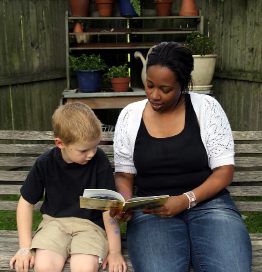Inquiry 1
1. Inquiry 1
Session 2: Communicating Effectively
Inquiry 1: Facts About Communication

© Jamie Wilson/shutterstock
Communication involves a sender, a message, and a receiver. The following are important points about communication:
- The sender communicates feelings or thoughts verbally (in words) and non-verbally (through body language).
- The message usually has two components, content and feeling.
- Body language includes facial expression and body movement.
- For the communication to be complete, the message has to be received by someone.
- The receiver interprets the message and sends a message back.
- The roles of sender and receiver are constantly shifting back and forth.

Have you ever wondered why communicating with some people is easier than with others? What makes you feel valued when someone you respect communicates with you?
Did you know that if you really know how to listen, you have mastered 80% of what is needed for good communication?
In the child care environment, there are many opportunities for a child care provider to use good listening skills. Learning these skills will enhance the effectiveness of your overall communication skills.

© matka_Wariatka/shutterstock
Listening
How can you listen effectively?
- Tune in to the other person and focus.
- Pay attention.
- Use words and body language to show that you are being attentive.
What are some ways that you show you are listening?
- nodding your head
- making eye contact
- asking questions
- leaning toward the speaker
Listening involves four main stages:
- selecting—deciding what you are going to listen to
- attending—making a conscious effort to pay full attention
- understanding—making sure that you understand correctly by asking questions to clarify or by repeating back what you understood
- remembering—trying your best to remember what the person has communicated
There are many factors that are barriers to, or that interfere with, your ability to listen. Consider the following barriers:
-
too much going on in the environment
assumption: something taken for granted or accepted as true without proof
prejudice: an adverse judgment or opinion formed without knowledge or examination of the facts
- too much on one’s mind (personal concerns)
- assumptions or prejudices (prejudging)
- personal beliefs or biases
How Child Care Providers Can Become Better Communicators
Develop a range of skills. Through practice you can learn how to communicate and resolve conflicts with care, compassion, and assertiveness. There are many books, workshops, and courses on effective communication.
Adapt communication appropriately. You can learn to adapt your communication depending on the situation (professional or personal), the developmental stage of the people with whom you are communicating, and the cultural background of the individuals with whom you are communicating.
Engage in dual perspectives. The better you understand the other person’s situation, the better you will be able to adapt your communication style to be effective. For example, if a parent is late for work and in a rush, you would be more successful getting your message across if you were to speak briefly with the parent rather than at length.
Monitor your communication. Being aware of how you feel when communicating and of how others are responding to you makes you a better communicator.
Make a commitment to effective communication. An important part of being an effective child care provider is to be committed to constantly improving your communication with children, parents, and co-workers.
Respect and understand differences. Depending on a child’s abilities, the child can communicate in different ways. As a child care provider it is important to recognize that each child will have his or her own unique style of communication. It is up to the child care provider to engage with the child and to learn the child’s style of communication.
From Henry. Everyday Encounters. © 2002 Nelson Education Ltd. Reproduced by permission. www.cengage.com/permissions